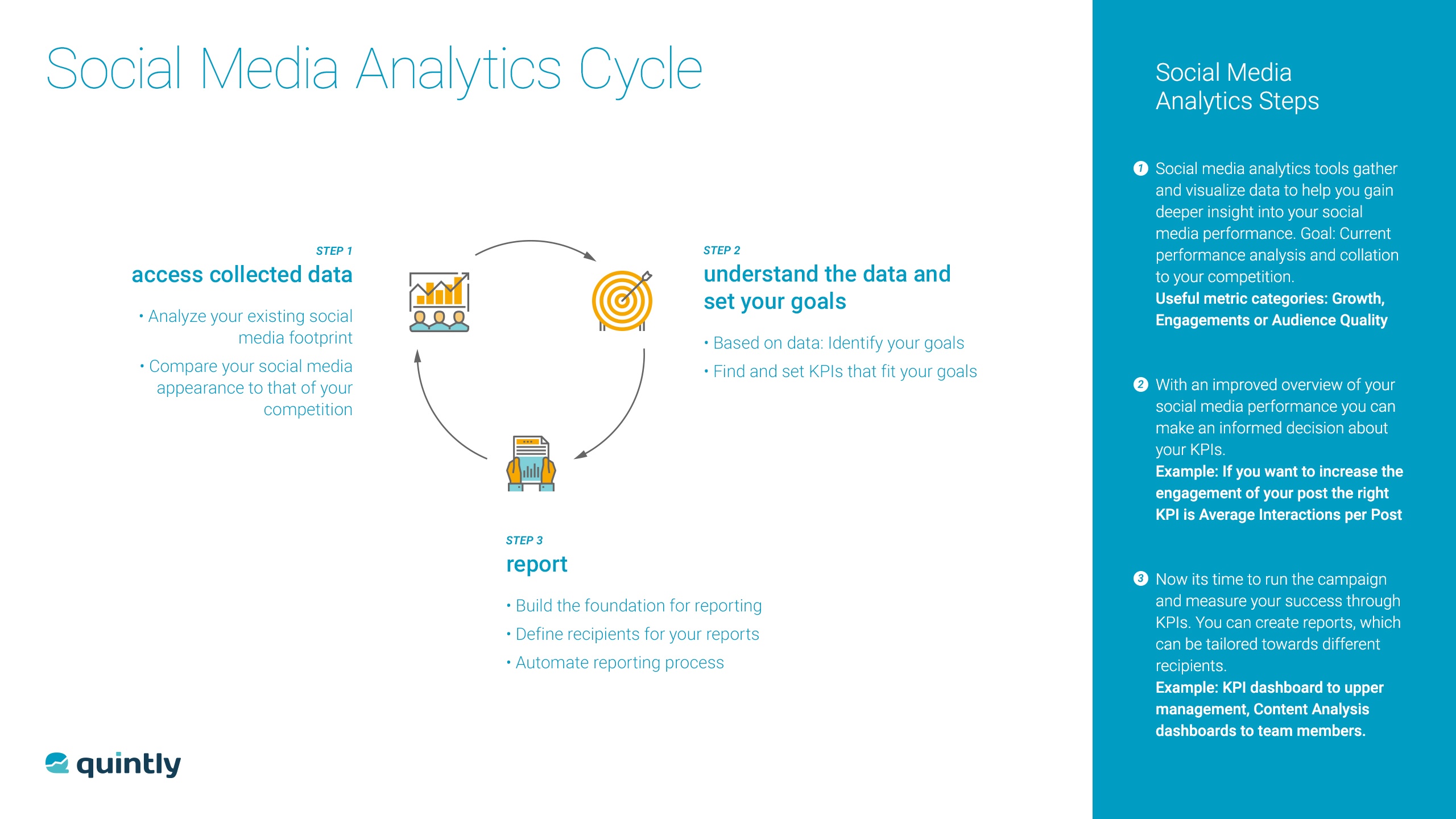
The following social media cycle will help you to constantly be ahead of your competition. Social Media with all its different facets can be overwhelming and has many aspects that are crucial to stay ahead of your competition. With the help of this Social Media Analytics Cycle (SMAC), businesses are able to efficiently set KPIs in order to achieve goals as well as report the performance to the correct recipients. It will help you systematize your social media analytics routine to stay ahead of your competitors.
Step 1 – Access collected data
Social media analytics tools like quintly collect and visualize data for you, so do not worry about this part. That’s why we start off by accessing the data that has already been collected. As this is the very first step of your analysis, the goal is to understand your already existing footprint in different social media channels. Firstly, you do that for your own company to receive a deeper insight into how your fan base grew network-specific. Secondly, businesses should switch from a purely internal view to a market view and take competitors into consideration. After the first step you should be able to answer the following questions:
- Which network seems to work best for you / your competition?
- Which player in the market achieved highest growth in the analyzed period?
- Who received most interactions on which network on which kind of posts?
- Do you / your competition manage to engage your community?
Helpful metrics: Growth, Engagement Metrics, Audience Quality
Step 2 – Understand collected data and set your goals
Now that you understood your and your competitors’ social media footprint you know what's working and what's not. Based on that knowledge, you are able to set goals.
So, here’s an example: You achieved 10k likes on Facebook and you are so far satisfied with your fan growth on Instagram, but you see that your competition received more likes in the past. Accordingly, your goal might be to increase the average amount of likes on your posts.
After defining the precise goal for the next quarter, it's time to set KPIs for controlling whether you were able to reach the set goals, or not.
In the example mentioned a good metric to choose would be Average Interactions of Post for Facebook and Instagram in order to check if the posted content is effective for raising the amount of likes.

Step 3 – Reporting
While analyzing, you ideally built your first social media analytics dashboard in order to bundle the right metrics in one place. Thus, you created the foundation of reporting as these dashboards are the canvas for your reports. Another helpful feature in quintly is that you are easily able to save a lot of time through automating reports.
Before you automate the social media reporting it is crucial to define the recipients of your reports. Different recipients need different information. For example, your upper management or clients are interested in different numbers than your close team members. To keep the former (upper management or clients) in the loop, just very basic numbers are needed. Thus, a basic report with the most important social media KPIs is sufficient.
Your team members that are involved in the creative process need detailed information on post level in order to effectively adjust tactics. Therefore, the chosen KPIs go into greater detail of your and your competitors’ posts. Check out the example for a social media KPI dashboard and also a more detailed one for a deeper analysis.
Conclusion
We created the Social Media Analytics Cycle together with some of our partners to ensure different challenges in the daily business routine can be managed even more effectively. Now that you know it’s three steps, you can easily apply it to your work. To sum things up, it leads you from a first analysis of you and your competitors to understanding your data and defining your goals. Further, it helps you set the correct goals and find KPIs that measure the success of those. Lastly, the social media analytics cycle helps you to set the foundation of your reporting.
By repeating these steps, you will have a solid basis for a successful social media campaign that can be adjusted after completing every cycle. In that way you won’t waste unnecessary financial resources or time. So why don’t you start using the Social Media Analytics Cycle now?
If you have any questions or remarks, feel free to leave a comment, send us an Email or engage with us on Facebook or Twitter.


Join the conversation. Leave us a comment below!